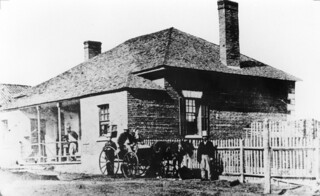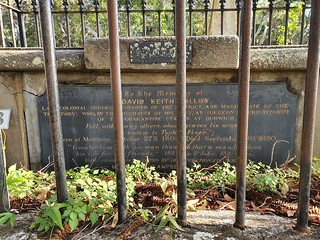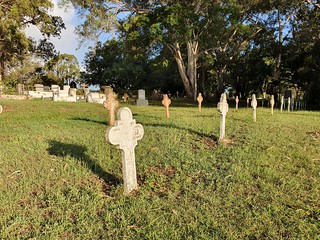From the convict barracks in what is now Queen Street, turning the corner into what is now George Street – on the riverside facing North Quay – there were first the old military barracks, turned into a lumberyard. Next to it, roughly starting opposite Adelaide Street and than all the way to Ann Street was the hospital. It started in tents. After much government bungling over plans and approvals they first building was only completed after two years, in 1827. There was a separate building for the military and a larger one for the convicts. First the surgeon resided in the hospital before a separate residence we built in 1831.
Dr Henry Cowper
The first doctor at the hospital was the at that time 25 year old Henry Cowper. At the age of 14 he started his apprenticeship in Sydney Hospital and at the age of 21 he became the youngest person to graduate medicine in Australia. In his apprenticeship he had been treating some of the most shocking accidents and the effects of flogging. Even before the age of 17 he had to relieve surgeon Dr Redfern when he was away.
He arrived in Brisbane in 1826, nearly a year after the settlement was started. He had to do his work in a large tent. It took one and a half year before he could actually practise in a more appropriate environment. Six convict attendants were assigned to the hospital.
As the harvest of the gardens was above expectations there was not enough room the Old Commissariat Store , soon after its completion a wing of the newly built hospital was used as a granary. As we will see below the summer of 1828/29 brought an extreme number of patients to the hospital and the granary was consequently turned into a hospital ward.
As there was no chaplain in the convict settlement, the doctor as a lay person, also had to perform the Divine Service every Sunday, and Henry also conduct burial rites for the dead, most of whom he would have first treated in his hospital.
Initially Dr Cowper lived in a wing of the hospital. Bowman had recommended building a separate surgeon’s residence, to create more space in the hospital. This was done and in 1831 it was added to the hospital precinct on the North Quay side about 250 meters from the corner of Queen Street and North Quay. A stable was situated at the back of the building as the doctor was allowed to have a horse to visit the Female Factory in Eagle Farm. Dr Cowper also received an assistant Dr Murray.

Most certainly also as an effect of the shocking work conditions Dr Cowper ‘s personal life was seriously effected. According to Dr Murray he was an excessive grog-drinker and smoker, and most ill-tempered and quarrelsome. He was disliked by the Commandant and the other officers. He was dismissed in 1832 after he together with the hospital clerk Halden and Richard, the captain of the ship ‘Governor Phillip’ had entered the Female Factory and where caught in compromising positions.
Murray continued his practise until 1835 and was replaced by Assistant Surgeon Robertson, who remained in that position for nearly three years.
Statistical information
From the very early beginning of the settlement diseases created havoc, especially typhoid and dysentery were prevalent. The subtropical climate, the lack of hygiene and the lack of clean drinking water, low food rations, and hard work for the convicts were major contributors to this situation. The medical situation in Moreton Bay can only be described as horrendous and this certainly had its effect on the young doctor. The buildings were also not well suited for the hot and humid Queensland climate and this further added to the deplorable state of health care.
Principal Medical Officer James Bowman and inspector of colonial hospitals in NSW arrived in the settlement in March 1829 and he reported that in January 1829 406 people had been in the hospital of which 11 died. In February the numbers were 368 hospitalised and 22 death. After his report improvements were made and the number had dropped to 195 in the hospital and 4 death. It is still astonishing to imagine this in a relative very small community.
No wonder that the hospital had a terrible reputation as so many patients died here. The settlement was ill prepared for the many tropical diseases. All adult death were male convicts. There were no death among the military and only a few hospitalisations for dysentery. Over 200 convicts died over a 15 year period – a 10% death-rate. Of them 144 died in the years 1828,1829 and 1830 (94 in 1829 alone). The harsh treatment of the convicts , especially the liberal use of the whip, lead to many infections. As their hygiene and nutrition conditions were very poor this will have been the major contributor to these deaths. In 1828, 50 convicts ended up in hospital as a result of severe flagellation. Captain Logan had increased the number of lashes for common offences from 50 to 200.
The situation changed after the death of Logan and by that time the measure implemented by James Brown also had taken effect. The deathrate dropped to around 5% and hospitalisation as a result of flagellation had become rare.
The hospital suffered a fire in 1835.
Dr. David Ballow
Dr. David Ballow took over the hospital in 1838 and lived in the surgery cottage till his death in 1850. He oversaw in 1849 the long overdue upgrade of the hospital desperately needed for the growing demands of the free settler’s community. There was no public health service and the hospital operated on a subscription basis, for those who could afford to donate. These people received tickets they could redeem if they needed medical treatment at the hospital.
Since 1840 Barlow was assisted by Stephen Simpson who was a a homeopath. Which obviously caused some problems among the establishment, but at all accounts Simpson did a good job and was well respected.
On 8 August 1850 the immigrant ship Emigrant arrived in Moreton Bay with typhus on board. The ship was quarantined at Dunwich on Stradbroke Island away from Brisbane. Forty people on the ship died, including the ship’s surgeon Dr George Mitchell. Initially Dr Mallon came from Brisbane to care for the quarantined patients at Dunwich but he too contracted the infection. Dr Ballow took his place and also contracted the disease and died in 1850

However, the ongoing complaints about the lack of a proper hospital for the rapidly growing population of Brisbane Town continued. Finally in 1867 a new hospital was built in Herston (Brisbane Hospital renamed in 1966 to Royal Brisbane and Women’s Hospital).
The old hospital was subsequently occupied by the in 1864 established police force. From here they moved to their new premises on the corner of Albert Street and Turbot Street in 1880. Soon afterwards the old hospital buildings were demolished.
In 1961, the quarantine station at Dunwich became a Benevolent Asylum to provide accommodation and care to poor people unable to care for themselves due to illness or infirmity. It opened on 13 May 1865 with the transfer of initial patients from the Benevolent Ward of the Brisbane General Hospital. Over 21,000 people were admitted to the asylum during its operation, with around 1000 to 1600 at any one time. Those who died in the asylum were generally buried in the Dunwich Cemetery unless families made other arrangements. In the 80 years spanning 1867-1947, 8,426 former inmates of the Dunwich Benevolent Asylum were buried in the Dunwich Cemetery.
It operated until 30 September 1946, after which the patients were transferred to the newly opened Eventide Home at Sandgate, a northern suburb of Brisbane. Most of the buildings were subsequently destroyed. However, some buildings remain including the heritage-listed St Mark’s Anglican Church and Dunwich Public Hall.
